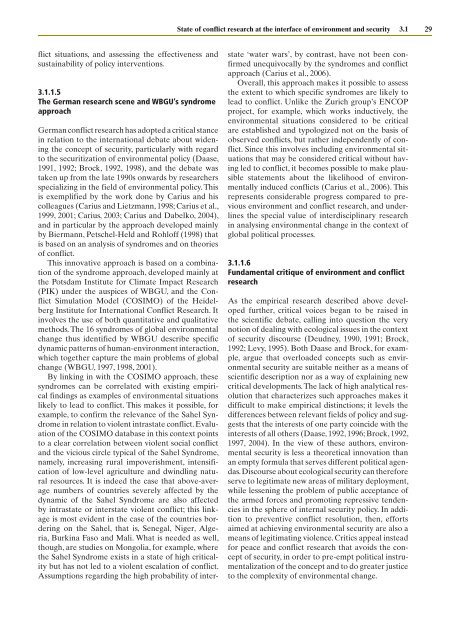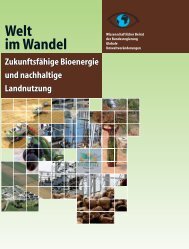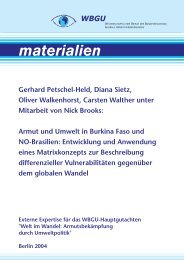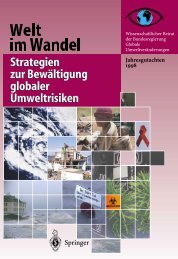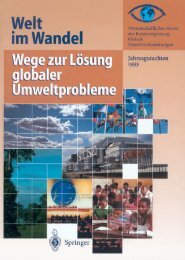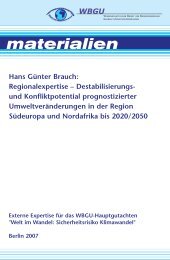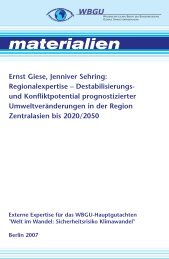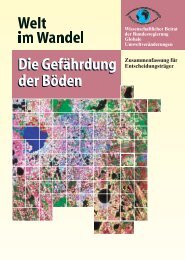World in Transition: Climate Change as a Security Risk - WBGU
World in Transition: Climate Change as a Security Risk - WBGU
World in Transition: Climate Change as a Security Risk - WBGU
Create successful ePaper yourself
Turn your PDF publications into a flip-book with our unique Google optimized e-Paper software.
flict situations, and <strong>as</strong>sess<strong>in</strong>g the effectiveness and<br />
susta<strong>in</strong>ability of policy <strong>in</strong>terventions.<br />
3.1.1.5<br />
The German research scene and <strong>WBGU</strong>’s syndrome<br />
approach<br />
German conflict research h<strong>as</strong> adopted a critical stance<br />
<strong>in</strong> relation to the <strong>in</strong>ternational debate about widen<strong>in</strong>g<br />
the concept of security, particularly with regard<br />
to the securitization of environmental policy (Da<strong>as</strong>e,<br />
1991, 1992; Brock, 1992, 1998), and the debate w<strong>as</strong><br />
taken up from the late 1990s onwards by researchers<br />
specializ<strong>in</strong>g <strong>in</strong> the field of environmental policy. This<br />
is exemplified by the work done by Carius and his<br />
colleagues (Carius and Lietzmann, 1998; Carius et al.,<br />
1999, 2001; Carius, 2003; Carius and Dabelko, 2004),<br />
and <strong>in</strong> particular by the approach developed ma<strong>in</strong>ly<br />
by Biermann, Petschel-Held and Rohloff (1998) that<br />
is b<strong>as</strong>ed on an analysis of syndromes and on theories<br />
of conflict.<br />
This <strong>in</strong>novative approach is b<strong>as</strong>ed on a comb<strong>in</strong>ation<br />
of the syndrome approach, developed ma<strong>in</strong>ly at<br />
the Potsdam Institute for <strong>Climate</strong> Impact Research<br />
(PIK) under the auspices of <strong>WBGU</strong>, and the Conflict<br />
Simulation Model (COSIMO) of the Heidelberg<br />
Institute for International Conflict Research. It<br />
<strong>in</strong>volves the use of both quantitative and qualitative<br />
methods. The 16 syndromes of global environmental<br />
change thus identified by <strong>WBGU</strong> describe specific<br />
dynamic patterns of human-environment <strong>in</strong>teraction,<br />
which together capture the ma<strong>in</strong> problems of global<br />
change (<strong>WBGU</strong>, 1997, 1998, 2001).<br />
By l<strong>in</strong>k<strong>in</strong>g <strong>in</strong> with the COSIMO approach, these<br />
syndromes can be correlated with exist<strong>in</strong>g empirical<br />
f<strong>in</strong>d<strong>in</strong>gs <strong>as</strong> examples of environmental situations<br />
likely to lead to conflict. This makes it possible, for<br />
example, to confirm the relevance of the Sahel Syndrome<br />
<strong>in</strong> relation to violent <strong>in</strong>tr<strong>as</strong>tate conflict. Evaluation<br />
of the COSIMO datab<strong>as</strong>e <strong>in</strong> this context po<strong>in</strong>ts<br />
to a clear correlation between violent social conflict<br />
and the vicious circle typical of the Sahel Syndrome,<br />
namely, <strong>in</strong>cre<strong>as</strong><strong>in</strong>g rural impoverishment, <strong>in</strong>tensification<br />
of low-level agriculture and dw<strong>in</strong>dl<strong>in</strong>g natural<br />
resources. It is <strong>in</strong>deed the c<strong>as</strong>e that above-average<br />
numbers of countries severely affected by the<br />
dynamic of the Sahel Syndrome are also affected<br />
by <strong>in</strong>tr<strong>as</strong>tate or <strong>in</strong>terstate violent conflict; this l<strong>in</strong>kage<br />
is most evident <strong>in</strong> the c<strong>as</strong>e of the countries border<strong>in</strong>g<br />
on the Sahel, that is, Senegal, Niger, Algeria,<br />
Burk<strong>in</strong>a F<strong>as</strong>o and Mali. What is needed <strong>as</strong> well,<br />
though, are studies on Mongolia, for example, where<br />
the Sahel Syndrome exists <strong>in</strong> a state of high criticality<br />
but h<strong>as</strong> not led to a violent escalation of conflict.<br />
Assumptions regard<strong>in</strong>g the high probability of <strong>in</strong>ter-<br />
State of conflict research at the <strong>in</strong>terface of environment and security 3.1<br />
state ‘ water wars’, by contr<strong>as</strong>t, have not been confirmed<br />
unequivocally by the syndromes and conflict<br />
approach (Carius et al., 2006).<br />
Overall, this approach makes it possible to <strong>as</strong>sess<br />
the extent to which specific syndromes are likely to<br />
lead to conflict. Unlike the Zurich group’s ENCOP<br />
project, for example, which works <strong>in</strong>ductively, the<br />
environmental situations considered to be critical<br />
are established and typologized not on the b<strong>as</strong>is of<br />
observed conflicts, but rather <strong>in</strong>dependently of conflict.<br />
S<strong>in</strong>ce this <strong>in</strong>volves <strong>in</strong>clud<strong>in</strong>g environmental situations<br />
that may be considered critical without hav<strong>in</strong>g<br />
led to conflict, it becomes possible to make plausible<br />
statements about the likelihood of environmentally<br />
<strong>in</strong>duced conflicts (Carius et al., 2006). This<br />
represents considerable progress compared to previous<br />
environment and conflict research, and underl<strong>in</strong>es<br />
the special value of <strong>in</strong>terdiscipl<strong>in</strong>ary research<br />
<strong>in</strong> analys<strong>in</strong>g environmental change <strong>in</strong> the context of<br />
global political processes.<br />
3.1.1.6<br />
Fundamental critique of environment and conflict<br />
research<br />
As the empirical research described above developed<br />
further, critical voices began to be raised <strong>in</strong><br />
the scientific debate, call<strong>in</strong>g <strong>in</strong>to question the very<br />
notion of deal<strong>in</strong>g with ecological issues <strong>in</strong> the context<br />
of security discourse (Deudney, 1990, 1991; Brock,<br />
1992; Levy, 1995). Both Da<strong>as</strong>e and Brock, for example,<br />
argue that overloaded concepts such <strong>as</strong> environmental<br />
security are suitable neither <strong>as</strong> a means of<br />
scientific description nor <strong>as</strong> a way of expla<strong>in</strong><strong>in</strong>g new<br />
critical developments. The lack of high analytical resolution<br />
that characterizes such approaches makes it<br />
difficult to make empirical dist<strong>in</strong>ctions; it levels the<br />
differences between relevant fields of policy and suggests<br />
that the <strong>in</strong>terests of one party co<strong>in</strong>cide with the<br />
<strong>in</strong>terests of all others (Da<strong>as</strong>e, 1992, 1996; Brock, 1992,<br />
1997, 2004). In the view of these authors, environmental<br />
security is less a theoretical <strong>in</strong>novation than<br />
an empty formula that serves different political agend<strong>as</strong>.<br />
Discourse about ecological security can therefore<br />
serve to legitimate new are<strong>as</strong> of military deployment,<br />
while lessen<strong>in</strong>g the problem of public acceptance of<br />
the armed forces and promot<strong>in</strong>g repressive tendencies<br />
<strong>in</strong> the sphere of <strong>in</strong>ternal security policy. In addition<br />
to preventive conflict resolution, then, efforts<br />
aimed at achiev<strong>in</strong>g environmental security are also a<br />
means of legitimat<strong>in</strong>g violence. Critics appeal <strong>in</strong>stead<br />
for peace and conflict research that avoids the concept<br />
of security, <strong>in</strong> order to pre-empt political <strong>in</strong>strumentalization<br />
of the concept and to do greater justice<br />
to the complexity of environmental change.<br />
29


